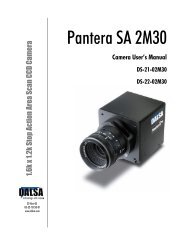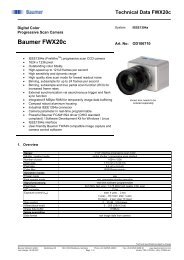TR-33 TR-34 TR-35 Trillium Rhino User's Manual - Frame Grabbers
TR-33 TR-34 TR-35 Trillium Rhino User's Manual - Frame Grabbers
TR-33 TR-34 TR-35 Trillium Rhino User's Manual - Frame Grabbers
You also want an ePaper? Increase the reach of your titles
YUMPU automatically turns print PDFs into web optimized ePapers that Google loves.
<strong>Trillium</strong> User’s <strong>Manual</strong> 17<br />
Note: The <strong>TR</strong>-36<br />
also offers a<br />
programmable<br />
exposure mode,<br />
in which line rate<br />
and exposure<br />
period are<br />
programmed<br />
through the<br />
RS232 interface.<br />
In programmable<br />
mode, an<br />
EXSYNC input is<br />
not necessary.<br />
EXSYNC<br />
EXSYNC triggers line readout and controls integration time. It can operate in two<br />
different exposure modes: edge mode or level mode. Exposure mode is selected<br />
using the RS232 interface.<br />
In edge mode, the falling edge of EXSYNC triggers line readout. The camera<br />
integrates light from one EXSYNC falling edge to the next. To control integration<br />
time independently from line rate, you must clock the PRIN signal with a LOW<br />
to HIGH edge at the desired amount of time before the next EXSYNC falling<br />
edge. Restricting EXSYNC to logic HIGH or logic LOW prevents line readout.<br />
Minimum high or low time is 100ns.<br />
In level mode, the camera integrates light as long as EXSYNC is in logic HIGH,<br />
and the falling edge of EXSYNC triggers line readout. For exposure control in<br />
this mode, PRIN does not need to be connected. While EXSYNC is LOW, the<br />
camera does not integrate light; integration begins on the rising edge of<br />
EXSYNC. Minimum EXSYNC low time is 2µs.<br />
Note: EXSYNC must not be clocked faster than the camera’s specified maximum<br />
line rate. To slightly improve offset performance at maximum line rates other<br />
than the defaults, see the section "Setting Line Rate (EXSYNC)".<br />
PRIN<br />
PRIN is an optional signal that can shorten the effective exposure time by<br />
resetting the pixels (draining accumulated charge) on the image sensor between<br />
EXSYNC-triggered line readouts. PRIN operates differently in different<br />
integration modes (edge mode and level mode). Exposure mode is selected<br />
using the RS232 interface.<br />
In edge mode, PRIN provides exposure control if it is clocked go from LOW to<br />
HIGH at a specific interval preceding the falling edge of EXSYNC. While PRIN is<br />
LOW, the camera does not integrate light; exposure effectively begins on the<br />
rising edge of PRIN. If PRIN is kept high, the integration time is maximized; if it<br />
is kept low the sensor collects no image information.<br />
In level mode, hold PRIN is not necessary for exposure control. In this mode, the<br />
camera will ignore PRIN and integrate light only while EXSYNC is high.<br />
PRIN is an optional signal; if not using PRIN, leave inputs unconnected.<br />
User1 (LVDS)<br />
User1 is a user-configurable LVDS input. It can be used to trigger camera<br />
functions that have been previously programmed through the serial interface.<br />
DALSA 03-32-10119-03
















